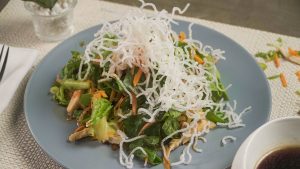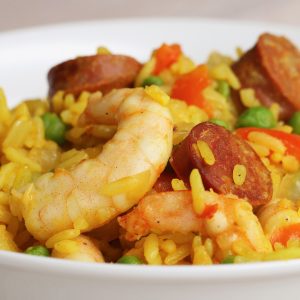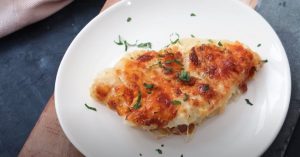Venture into the heart of traditional German cuisine with this rustic German potato noodles recipe. This dish, known as 'Schupfnudeln', is a comforting staple in German kitchens, particularly in the southern regions. The soft potato noodles mixed with a buttery sauce and topped with crispy bacon and fresh green onions is a heavenly combination that is sure to warm your heart and your stomach.
This recipe uses common ingredients found in most supermarkets. However, if you're not familiar with nutmeg, it's a warming spice often used in baking and cooking. It adds a distinctive warm, sweet flavor. You'll find it in the spice aisle. Be sure to pick up yellow potatoes for this recipe - they have a buttery, rich flavor and creamy texture that works well for the potato noodles.
Ingredients for Rustic German Potato Noodles Recipe
Yellow potatoes: These are the star of the dish. Yellow potatoes provide a dense, creamy texture and buttery flavor.
Eggs: Binding agent for the potato dough.
Salt: Enhances the flavor of the other ingredients.
Nutmeg: Adds a warm, sweet, and nutty flavor.
Flour: Provides structure to the noodles.
Butter: Adds a rich, creamy flavor and helps to create a light, delicious sauce.
Bacon: Adds a smoky flavor and a crunchy texture.
Chicken broth: Forms the base of the sauce.
White wine: Adds depth and complexity to the sauce.
Green onion: Adds a fresh, vibrant flavor and texture.
One reader, Jojo Coyle says:





The rustic German potato noodles recipe is a delightful comfort food. The noodles are hearty and flavorful, and the bacon and green onions add a delicious touch. The combination of ingredients creates a rich and satisfying dish that's perfect for a cozy family dinner.
Techniques Required for Making Rustic German Potato Noodles
How to boil potatoes: Boil the potatoes in salted water for about 25 minutes or until they are tender.
How to make the dough: Combine the mashed potatoes with eggs, salt, nutmeg, and flour, then knead into a smooth dough.
How to shape the noodles: Roll the dough into logs, cut into 1-inch pieces, and roll them into noodle shapes.
How to cook the noodles: Boil the noodles in salted water until they float to the surface, indicating they are cooked.
How to fry the noodles and bacon: Melt butter in a pan, add the noodles and bacon, and fry until golden brown on all sides.
How to make the sauce: Add chicken broth and white wine to the pan and let it reduce until the sauce becomes slightly creamy.
How to serve: Top the noodles with green onions before serving.
How To Make Rustic German Potato Noodles
A certainly healthy choice for noodle lovers, this potato noodles recipe made from rustic German potatoes is a dish that is scrumptious on its own.
Serves:
Ingredients
- 4yellow potatoes,we used yukon gold potatoes
- 2eggs
- 1tspsalt
- ¼tspnutmeg
- 3cupsflour
- 1tbspbutter
- ½cupbacon,diced
- 1cupchicken broth
- ½cupwhite wine
- 1bunchgreen onion,chopped
- water,to boil
- salt,for boiling water
Instructions
-
Peel potatoes. Cut them into 1-inch slices and boil them in salted water for 25 minutes or until they are tender.
-
After boiling, take them out and let them cool for 10 minutes, allowing them to steam to remove excess moisture.
-
Mash potatoes until no lumps remain.
-
Add eggs, salt, nutmeg, and 2 cups flour, and knead into a dough.
-
If dough is too sticky, add more flour until it holds its shape but is still smooth.
-
Put a piece of dough on a floured surface and roll into a 1-inch (2.5 cm) thick log.
-
Cut in 1-inch pieces and roll them carefully in your floured palm for a noodle shape.
-
Repeat with the remainder of the dough.
-
Boil noodles in a large pot with salted water.
-
Stir carefully once or twice to make sure noodles don’t stick to bottom of the pan.
-
Once they float on the surface, they are cooked and ready to be taken out.
-
In a medium-sized pan, melt the butter.
-
Add noodles and bacon and fry until both are golden brown on all sides.
-
Add chicken broth and white wine and let reduce for a few minutes until sauce becomes slightly creamy.
-
Top with green onions before serving.
Nutrition
- Calories: 675.83kcal
- Fat: 12.46g
- Saturated Fat: 4.81g
- Trans Fat: 0.14g
- Monounsaturated Fat: 4.44g
- Polyunsaturated Fat: 2.06g
- Carbohydrates: 114.11g
- Fiber: 7.98g
- Sugar: 4.03g
- Protein: 20.56g
- Cholesterol: 98.73mg
- Sodium: 1078.35mg
- Calcium: 78.78mg
- Potassium: 1218.03mg
- Iron: 3.83mg
- Vitamin A: 74.97µg
- Vitamin C: 47.40mg
Technique Tip for Perfect Rustic German Potato Noodles
When rolling out your potato noodle dough, it's important to keep the surface and your hands well-floured to prevent sticking. However, be careful not to overdo it with the flour as it can make your noodles tough. If the dough is still too sticky, it's better to knead in a little more flour rather than using it all on the surface. This will ensure your noodles are smooth and tender, not tough or chewy.
Time-Saving Tips for Making Rustic German Potato Noodles Recipe
Prep ahead: Boil and mash the potatoes the day before and store them in the fridge. This will save time on the day of cooking.
Use a potato ricer: Using a potato ricer to mash the potatoes will result in a smoother texture, saving time on mashing and ensuring a consistent dough.
Boil in batches: Boil the potato noodles in batches to ensure they cook evenly and don't stick together, saving time on untangling them later.
Freeze for later: Make a larger batch of potato noodles and freeze them for later use. This will save time on preparation for future meals.
One-pot cooking: Consider using a large pot to boil the noodles and then cook them in the same pot with the sauce, saving time on cleaning up multiple dishes.
Consistent size: Try to roll the dough into uniformly sized noodles to ensure even cooking and a consistent texture.
Pre-chopped ingredients: Pre-chop the bacon and green onions in advance to save time during the cooking process.
Efficient multitasking: While the potatoes are boiling, prepare the other ingredients to maximize efficiency in the kitchen.
Substitute Ingredients For Rustic German Potato Noodles Recipe
yellow potatoes - Substitute with Yukon Gold potatoes: Yukon Gold potatoes have a similar waxy texture and buttery flavor, making them a great substitute for yellow potatoes in this recipe.
eggs - Substitute with flax eggs (1 tbsp ground flaxseed + 3 tbsp water per egg): Flax eggs can be used as a vegan alternative to eggs, providing binding and moisture to the dough.
nutmeg - Substitute with allspice: Allspice can add a warm and aromatic flavor similar to nutmeg, making it a suitable substitute in this recipe.
flour - Substitute with gluten-free flour blend: For a gluten-free option, a blend of gluten-free flours can be used to achieve a similar texture in the potato noodles.
bacon - Substitute with smoked tofu or tempeh: Smoked tofu or tempeh can provide a smoky flavor and a meaty texture as a vegetarian alternative to bacon.
chicken broth - Substitute with vegetable broth: Vegetable broth can be used as a vegetarian or vegan alternative to chicken broth, adding depth of flavor to the dish.
white wine - Substitute with apple cider vinegar: Apple cider vinegar can add a tangy and slightly sweet flavor similar to white wine, enhancing the overall taste of the dish.
green onion - Substitute with chives: Chives can provide a mild onion flavor and a pop of color, serving as a suitable substitute for green onions in this recipe.
Best Way to Present Rustic German Potato Noodles
Elevate the plating: When presenting the rustic German potato noodles, focus on creating an artful arrangement on the plate. Use edible flowers and microgreens to add a pop of color and freshness to the dish.
Incorporate texture: Introduce a contrast in textures by adding a crispy element such as crispy bacon or fried shallots to provide a delightful crunch alongside the soft potato noodles.
Emphasize the sauce: Drizzle the creamy chicken broth and white wine reduction over the noodles with precision, ensuring that each strand is coated evenly. The sauce should be the star of the dish, so pay attention to its placement and distribution.
Utilize negative space: Allow the plate to breathe by strategically leaving areas of the plate uncovered. This will create a sense of balance and sophistication in the overall presentation.
Attention to detail: Garnish the dish with finely chopped chives or parsley to add a touch of elegance and a burst of flavor. The garnish should be meticulously placed to showcase your culinary finesse.
Essential Tools for Making Rustic German Potato Noodles
- Peeler: A peeler is used to remove the skin from fruits and vegetables, making it easier to prepare ingredients for cooking or baking.
- Pot: A pot is a versatile cooking vessel used for boiling, simmering, and stewing ingredients. It's an essential tool for preparing soups, stocks, and boiling potatoes.
- Colander: A colander is a bowl-shaped kitchen tool with perforations or holes used to drain liquids from food, such as pasta or boiled potatoes.
- Masher: A masher is a utensil used to crush or mash cooked potatoes, ensuring a smooth and creamy texture for dishes like mashed potatoes or potato noodles.
- Rolling pin: A rolling pin is a cylindrical tool used to flatten and shape dough, such as for rolling out the potato noodle dough to the desired thickness before cutting into noodles.
- Skillet: A skillet, or frying pan, is a flat-bottomed pan used for frying, searing, and browning ingredients. It's essential for cooking bacon and frying potato noodles.
- Saucepan: A saucepan is a deep cooking pan with a handle and a lid, ideal for making sauces, heating liquids, and reducing broths or wine for the potato noodle recipe.
- Knife: A knife is a crucial tool for peeling, slicing, and chopping ingredients, such as peeling potatoes, slicing green onions, and cutting bacon for the recipe.
- Mixing bowl: A mixing bowl is used to combine and knead ingredients, such as mixing the potato dough and flour to form the noodle dough.
- Wooden spoon: A wooden spoon is a versatile kitchen tool used for stirring, mixing, and sautéing ingredients, making it useful for stirring the potato noodles and bacon in the skillet.
How To Store and Freeze Rustic German Potato Noodles
- Allow the rustic german potato noodles to cool completely before storing or freezing.
- For short-term storage, place the cooled noodles in an airtight container and refrigerate for up to 3-4 days.
- To freeze the noodles:
- Spread the cooled noodles on a baking sheet lined with parchment paper, ensuring they are not touching each other.
- Place the baking sheet in the freezer for 1-2 hours, or until the noodles are frozen solid.
- Transfer the frozen noodles to a freezer-safe container or resealable plastic bag, removing as much air as possible to prevent freezer burn.
- Label the container or bag with the date and contents.
- Frozen rustic german potato noodles can be stored for up to 2-3 months.
- To reheat refrigerated noodles:
- Place the noodles in a pan with a small amount of butter or olive oil over medium heat.
- Stir gently until the noodles are heated through and any added sauce or toppings are warm.
- To reheat frozen noodles:
- Remove the desired portion of frozen noodles from the container or bag.
- Place the noodles in a colander and run them under cool water for a few seconds to thaw slightly.
- Add the noodles to a pan with a small amount of butter or olive oil over medium heat.
- Stir gently until the noodles are heated through and any added sauce or toppings are warm.
- Note: Reheated noodles may have a slightly different texture compared to freshly made noodles, but they will still be delicious and satisfying.
How To Reheat Leftover Rustic German Potato Noodles
- The best way to reheat leftover rustic german potato noodles is to use a skillet or frying pan. Start by melting a tablespoon of butter in the pan over medium heat. Once the butter is melted, add the leftover noodles to the pan and toss them gently to coat them in the butter.
- If the noodles seem a bit dry, you can add a splash of chicken broth or white wine to the pan to help moisten them up. This will also help to revive the flavors of the bacon and green onions.
- Cover the pan with a lid and let the noodles heat through for about 5-7 minutes, stirring occasionally to prevent them from sticking to the bottom of the pan. You want the noodles to be heated through and slightly crispy on the outside.
- If you prefer a softer texture, you can also reheat the noodles in the microwave. Place the leftover noodles in a microwave-safe dish and cover them with a damp paper towel. Microwave the noodles on high for 1-2 minutes, or until they are heated through.
- Another option is to reheat the noodles in the oven. Preheat your oven to 350°F (175°C) and place the leftover noodles in an oven-safe dish. Cover the dish with foil and bake the noodles for 10-15 minutes, or until they are heated through.
- Regardless of which method you choose, be sure to taste the noodles before serving and adjust the seasoning as needed. You may want to add a pinch of salt or a sprinkle of fresh green onions to brighten up the flavors.
- If you find that the noodles are a bit too dry after reheating, you can always add a bit more butter or chicken broth to help moisten them up. Just be careful not to add too much liquid, as this can make the noodles mushy.
Random Fact About Rustic German Potato Noodles
The German potato noodles, also known as Schupfnudeln, are a traditional dish in southern Germany and Austria. They are often served as a side dish or main course and are popular at festivals and markets. The dish has been a part of German cuisine for centuries and is loved for its hearty and comforting flavors. The noodles are versatile and can be served with a variety of toppings, making them a favorite among locals and visitors alike.
Is Making Rustic German Potato Noodles Economical for Home Cooking?
This rustic German potato noodles recipe is highly cost-effective for a household. Potatoes and flour are affordable staples, while bacon and chicken broth add flavor without breaking the bank. The dish's simplicity and use of basic ingredients make it a budget-friendly option. The approximate cost for a household of 4 people is around $10-15, earning it a solid 8/10 for cost-effectiveness.
Are Rustic German Potato Noodles Healthy or Unhealthy?
This rustic German potato noodle recipe, while comforting and flavorful, is not particularly healthy. The dish is high in carbohydrates due to the potatoes and flour, and the addition of bacon and butter increases the saturated fat content. The recipe also lacks a significant source of vegetables, which would provide essential vitamins, minerals, and fiber.
To make this recipe healthier, consider the following suggestions:
- Replace half of the potatoes with cauliflower or zucchini to reduce the carbohydrate content and increase the vegetable intake
- Use whole wheat flour instead of all-purpose flour to add more fiber and nutrients
- Opt for turkey bacon or lean ham instead of regular bacon to reduce the saturated fat content
- Replace the butter with olive oil, which is a healthier fat option
- Increase the amount of green onions and add other vegetables like spinach, peas, or carrots to boost the nutrient content
- Use low-sodium chicken broth to reduce the overall sodium content of the dish
By incorporating these changes, you can create a more balanced and nutritious meal that still retains the comforting flavors and textures of the original recipe. The addition of vegetables and the use of healthier ingredients will make this dish a more well-rounded and satisfying option, while still paying homage to its rustic German roots.
Editor's Thoughts on This Rustic German Dish
The rustic German potato noodles recipe is a delightful blend of hearty flavors and comforting textures. The use of simple ingredients like potatoes, eggs, and flour creates a satisfying base, while the addition of bacon, chicken broth, and white wine elevates the dish to a new level of richness. The nutmeg adds a warm, aromatic note, and the green onions provide a fresh, vibrant finish. The process of making the noodles from scratch adds a personal touch and a sense of tradition to the dish. Overall, this recipe offers a wonderful balance of flavors and textures, making it a perfect choice for a cozy, homemade meal.
Enhance Your Rustic German Potato Noodles Recipe with These Unique Side Dishes:
Alternative Recipes Similar to Rustic German Potato Noodles
Suggested Appetizers and Desserts to Serve with Rustic German Potato Noodles
Why trust this Rustic German Potato Noodles Recipe:
This rustic German potato noodles recipe is a delightful comfort food that showcases the hearty flavors of potatoes and bacon. The combination of nutmeg and green onions adds a depth of flavor, while the use of chicken broth and white wine creates a rich and savory sauce. The step-by-step instructions ensure that the noodles are perfectly cooked and the dish is brought together with a touch of butter. Trust in the traditional ingredients and cooking techniques to deliver an authentic and satisfying dining experience.
Was this page helpful?
Have your own special recipe to share? Submit Your Recipe Today!












